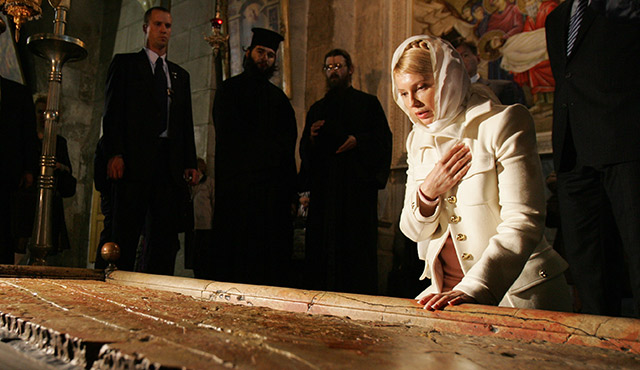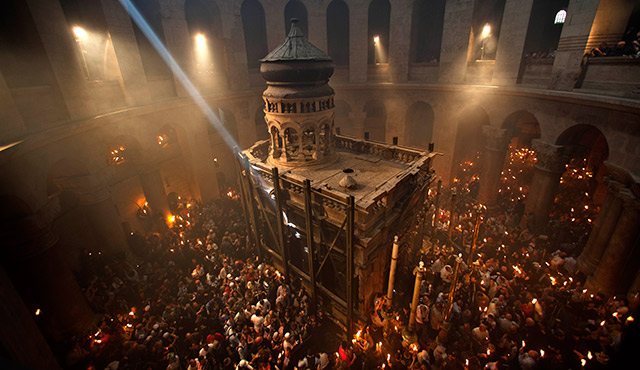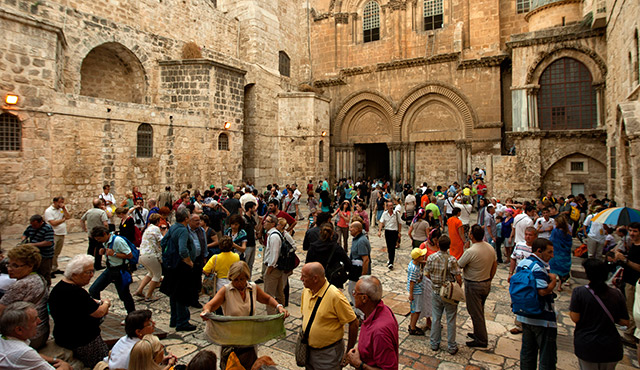First-time Christian visitors to Jerusalem, recalling paintings of the crucifixion, or possibly films dealing with Jesus’ passion and death, may set out for the hill of Calvary only to be confused and possibly disappointed when they discover that the hill doesn’t exist.
At least it doesn’t exist in quite the form they may have expected. The mount where Jesus was crucified—not an imposing hill, but more of a limestone knoll—has been contained for centuries indoors, beneath one of many ornate altars in what is surely one of the world’s most unusual buildings.
It’s also the holiest site in the Christian faith: the Church of the Holy Sepulchre. Containing, in a series of almost labyrinthine structures, the places of Christ’s crucifixion, anointing, burial and resurrection—including the scenes of the last five Stations of the Cross—it has been a place of almost constant pilgrimage and deep reverence for 2,000 years.
Today, rubber-soled athletic shoes tread the same stone floors and staircases as did feet once shod in hard leather sandals and Medieval armor. They come every day to a church like no other, for an experience like no other.
“It’s the most wonderful experience to go there and think that you’re standing on holy ground,” says Kathleen Robinson of Santa Ana. “You’re at the most holy place in Christendom.”
And one of the most confusing and bustling. Robinson, a member of the Equestrian Order of the Holy Sepulchre—a ceremonial Catholic organization dedicated to, among other purposes, supporting the Christian population of the Holy Land and preserving the holy Christian sites there—has made 11 pilgrimages to Jerusalem and has visited the Church of the Holy Sepulchre “between 20 and 30 times.” She says a tour of the church, depending on the season, time of day and general mood of the often overflow crowds, can range from serene to chaotic.
“Late in the afternoon is probably the best time to go,” she says. “There doesn’t seem to be that much of a crowd after 5 in the afternoon. It can be mind-blowing. There’s often a lot of confusion, but I tell people to think about what went on that day at Calvary. There was certainly a lot of confusion then.”
Much of the characteristic bustle has to do with the fact that the church is administered by three Christian faiths: the Armenian Orthodox Church, the Greek Orthodox Church and the Latin (or Roman) Catholic Church (represented by the Franciscan Order of monks). The entire site is under Israeli control, and the keys to the doors are held by two Muslim families. A long-standing set of regulations known as The Status Quo determines how, when and where the different religious communities take turns praying, holding services, and having access to certain parts of the church. Representatives of the Coptic, Syrian and Ethiopian churches also participate.
“It can be very controlled and very restrictive, but it was agreed upon a long time ago,” says Bishop Emeritus Tod Brown, who, during a pilgrimage last September, concelebrated Mass at the church with a group of American bishops. “There are separate liturgies in separate areas. There can be some disagreements. It really brings home the division of the [Christian] churches, and I’d urge everyone to pray for the union of them.”
The church lies at the end of the Via Dolorosa, the route Jesus trod with the cross from his place of condemnation to Golgotha. The walk winds through narrow cobbled streets lined with stores, shops and kiosks and—once again, depending on the day, time and season—it can be quite crowded. Robinson estimated that the entire route can be walked in 45 minutes, including brief stops at each Station of the Cross along the way (which, she adds, are sometimes poorly marked).
“I would not go without a guide the first time,” she says.
Pilgrims arriving at the church approach the façade of the original Crusader church and enter through a single door. Immediately inside the door and to the right are a set of steep stone stairs that leads up to a pair of chapels. “Those steps are worn from thousands and thousands of pilgrims over hundreds of years,” says Robinson. The Chapel of the Crucifixion, belonging to the Latin Church, commemorates the spot of Jesus’ stripping and crucifixion. The Chapel of Calvary, belonging to the Greek Orthodox Church, where it is possible to reach through a silver disk and touch the actual rock of Calvary, a limestone outcropping beneath the floor and visible through glass.
Back on the main floor and just inside the front door is the Stone of the Anointing, a stone slab on which the body of Jesus was said to be laid for anointing before burial.
Several steps to the left of the slab is the rotunda beneath the large dome, known as the Anastasis. In the center of the rotunda—which is one of the areas of the church that has undergone the fewest changes since the time of Constantine—is the tomb of Christ, contained in a structure that two pilgrims call “a church within a church within a church.”
Terry and Kathy McGaughan of Irvine, both members of the Equestrian Order of the Holy Sepulchre, made their first pilgrimage to the site five years ago. They recalled entering the tomb through, successively, the Edicule (a kind of outer chamber), the Chapel of the Angel (a vestibule about 3.5 yards long by 4 yards wide) and finally the tiny burial chamber itself.
The McGaughans say that the tomb can accommodate only three visitors at a time, and Robinson adds that when the church is particularly crowded, the wait in line to enter the tomb can be two hours.
Still, says Robinson, when the time comes to actually enter, the spiritual experience is palpable. “You can put your hand on it and say, ‘This is it. This is the spot,’” she says. Adds Terry McGaughan, “This is why people come from around the world to the Holy Land. It is THE place if you’re a Catholic Christian. It’s just a great place to be. This is the very foundation of our faith, and it changed our perceptions and our faith in general, being where Christ died and was buried. It really brings the Gospel to life.”
Perhaps Robinson’s best piece of advice for first-time visitors to the Church of the Holy Sepulchre: go twice during you visit to Jerusalem.
“The first time you go the crowds can be pretty pushy and distracting,” she says, and people forget to pray. “So I’d say go for the first time with your group and take your pictures. Then come back with a good guide book and really take the time to pray. Because this is a true pilgrimage site.”
HISTORICAL TIMELINE FOR THE CHURCH OF THE HOLY SEPULCHRE
- In 33 A.D. Calvary was part of what was once a vast limestone quarry outside the city walls. When the quarry was abandoned, local residents grew vegetables there and carved family tombs in the old quarry walls. Golgotha itself was a separate rocky knoll.
- Around 135, following the Jewish revolt against Roman domination and the destruction of Jerusalem, Emperor Hadrian ordered the construction of a new city, Aelia Capitolina. Golgotha disappeared under the new buildings, which became the center of the city. A temple honoring Roman gods occupied the area. A statue of Jupiter was placed on the site of the Resurrection and a marble statue of Venus occupied the site of the crucifixion.
- The Emperor Constantine, around 325, ordered the destruction of the pagan structures on Calvary and initiated excavations for the tomb of Christ. Both the tomb and the rock knoll of Golgotha were unearthed, and Constantine ordered a great basilica, known as the Martyrium, and other structures to be built on the site. A huge semicircular structure, the Anastasis, contained the tomb of Christ.
- When Jerusalem was conquered by the Persians in 614, Constantine’s splendid structures were destroyed, as was most of the surrounding city. Christians in Tiberias, Damascus, Tyre and Alexandria funded a restoration, however. When Arab forces entered the city in 638, they were under orders not to destroy or occupy Christian holy sites. Still, the complex suffered fires in 841, 938 and 966. It was repaired each time. In 1009, Khalif al-Hakim of Egypt ordered the destruction of the Church of the Holy Sepulchre. When restoration began several years later, the only major Constantinian element that was retained was the Anastasis.
- With the arrival of the Crusaders in 1149, the site took on many of the characteristics that are recognizable today: the rotunda over the tomb and various chapels were joined under one roof, within a cruciform cathedral; a chapel to St. Helena (Constantine’s mother) was built; and the south parvis, or entry court, was constructed with a bell tower.
- During the 13th and 14th centuries, various Christian faith traditions established partial control over sections of the Church of the Holy Sepulchre. The Latin, or Roman, Church was represented by the Franciscan Order, as it is today.
- Today three major religious communities—Greek Orthodox, Armenian Orthodox and Latin (Roman) Catholic—administer the church and supervise restoration efforts. The site is under Israeli control.



